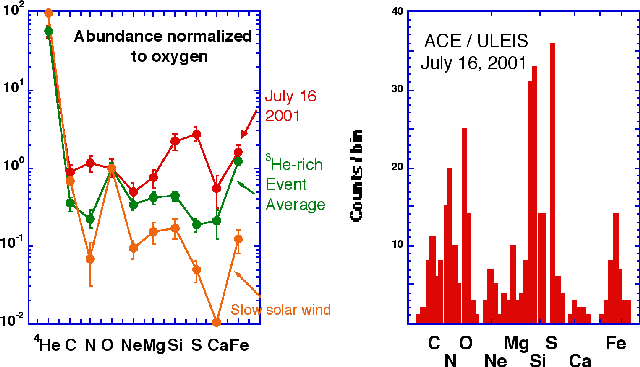
| ACE News Archives | ACE News #62 - May 23, 2002 |
ACE News Archives |
| ACE Science Nuggets |
|
ACE Science Nuggets |

Small solar energetic particle events rich in the rare isotope 3He have long been known to contain systematic enrichments of heavy ions. They also show high ionization states indicative of a very hot (~10 MK) plasma. The enrichments increase with mass as shown in the left panel, which compares abundances in 3He-rich events from a survey by ACE/ULEIS (green points) with the slow solar wind (orange points). If abundances are normalized to oxygen = 1, then elements such as Ne-S are enriched by factors of 2-4, and Fe by a factor of 10. These heavy enrichments do not correlate with the size of the 3He/4He ratio in the events. Proposed acceleration mechanisms that explain the heavy ion enhancements focus on their somewhat different charge-to-mass ratios, which are caused by the different ionization states for a given coronal temperature.
On July 16, 2001, ULEIS observed a 3He rich event (3He/4He ~ 1) that had a startlingly different pattern, shown in the red points in the left panel, and in the mass histogram in the right panel (data for E>200 keV/n). Not only is the element N enhanced by a factor of ~10, but the enhancements peak at Si and S, and are somewhat smaller for Fe. This is markedly different from the general pattern seen in prior surveys, where the enhancements generally increased with increasing mass. Since N and O have nearly identical charge-to-mass ratios at coronal temperatures, enhancement of N in the July 16 event would require low temperatures if its charge-to-mass ratio was related to the mechanism for the enhancement. Temperatures as low as 200,000K are indicated in this case, in stark contrast to the high temperatures inferred from ionization state studies in other events. In two similar events observed by ULEIS, the ACE/SEPICA instrument was able to measure the Fe charge state, and found values lower than normal for 3He rich events (M. Popecki, private communication). These new observations have revealed unexpected properties of 3He-rich events. Just as the first observations of enriched 3He provided constraints on the possible acceleration mechanisms, these puzzling new ACE results enable us to probe further into the processes that accelerate ions in solar flares.
Contributed by Glenn Mason, Joe Mazur, and Joe Dwyer. Published in ApJ Letters 563, 403, 2002.
Last modified 23 may 2002, by
Andrew Davis